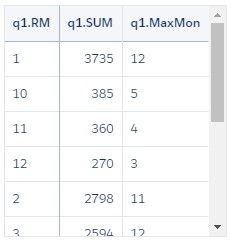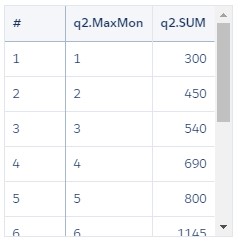I do have two data streams q1 and q2. I want to merge q2.SUM into q1 if they both have the same value in MaxMon.
It looks so obvious, but I am lost in between all this cogroup and union magic. This is how I load those two data streams:
q = load "RetentionDATA1";
q1 = group q by 'Month_of_Retention';
q1 = foreach q1 generate q1.'Month_of_Retention' as 'q1.RM', sum(q1.'MONTHLY_FEE') as 'q1.SUM', toString(toDate(max(q1.'FIRST_SIGN_UP_sec_epoch')), "M") as 'q1.MaxMon';
q2 = filter q by 'Month_of_Retention' == "1";
q2 = group q2 by ('FIRST_SIGN_UP_Year', 'FIRST_SIGN_UP_Month');
q2 = foreach q2 generate toString(toDate(max(q2.'FIRST_SIGN_UP_sec_epoch')), "M") as 'q2.MaxMon', sum(sum(q2.'MONTHLY_FEE')) over([.. 0] partition by all order by ('FIRST_SIGN_UP_Year', 'FIRST_SIGN_UP_Month')) as 'q2.SUM';
So far so good. Now I want to do the ‘merging’. Below are some examples and outcomes of my attempts:
result = cogroup q1 by ('q1.MaxMon') , q2 by ('q2.MaxMon');
result = foreach result generate first(q1.'q1.RM') as 'q1.RM', sum(q1.'q1.SUM') as 'q1.SUM', sum(q2.'q2.SUM') as 'q2.SUM)';
The results with q1.RM=3,4,8 are missing. I might understand 3 and 4, as those have a MaxMon matching two times. But why 8? (Same result if I do it with the keyword left for left join.)
Any other idea, how to join those tables, to get to the result described above? I need a table like this: q1.RM | q1. Sum | q2.SUM where q1.MaxMon equals q2. MaxMon
This is the full query:
q = load "RetentionDATA1";
q1 = group q by 'Month_of_Retention';
q1 = foreach q1 generate q1.'Month_of_Retention' as 'q1.RM', sum(q1.'MONTHLY_FEE') as 'q1.SUM', toString(toDate(max(q1.'FIRST_SIGN_UP_sec_epoch')), "M") as 'q1.MaxMon';
q2 = filter q by 'Month_of_Retention' == "1";
q2 = group q2 by ('FIRST_SIGN_UP_Year', 'FIRST_SIGN_UP_Month');
q2 = foreach q2 generate toString(toDate(max(q2.'FIRST_SIGN_UP_sec_epoch')), "M") as 'q2.MaxMon', sum(sum(q2.'MONTHLY_FEE')) over([.. 0] partition by all order by ('FIRST_SIGN_UP_Year', 'FIRST_SIGN_UP_Month')) as 'q2.SUM';
result = cogroup q1 by ('q1.MaxMon') left, q2 by ('q2.MaxMon');
result = foreach result generate first(q1.'q1.RM') as 'q1.RM', sum(q1.'q1.SUM') as 'q1.SUM', sum(q2.'q2.SUM') as 'q2.SUM)';




